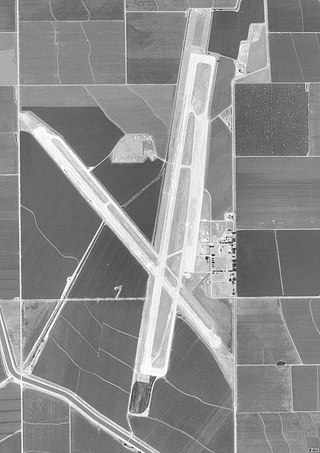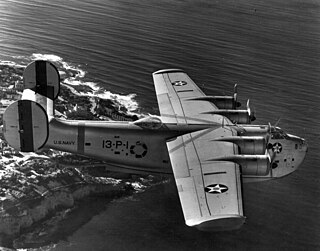Related Research Articles

The Douglas C-47 Skytrain or Dakota is a military transport aircraft developed from the civilian Douglas DC-3 airliner. It was used extensively by the Allies during World War II. During the war the C-47 was used for troop transport, cargo, paratrooper, for towing gliders and military cargo parachute drops. The C-47 remained in front-line service with various military operators for many years. It was produced in approximately triple the numbers as the larger, much heavier payload Curtiss C-46 Commando, which filled a similar role for the U.S. military.

Naval Air Station Glenview or NAS Glenview was an operational U.S. Naval Air Station from 1937 to 1995. Located in Glenview, Illinois, a suburb of Chicago, the air base primarily operated training aircraft as well as seaplanes on nearby Lake Michigan during World War II. Reconfigured as a Naval Air Reserve base following World War II, NAS Glenview supported Naval Air Reserve, Marine Air Reserve/4th Marine Aircraft Wing, and U.S. Army Reserve 244th Aviation Group as well as an active duty Coast Guard Air Station.

Naval Air Station Jacksonville is a large naval air station located approximately eight miles (13 km) south of the central business district of Jacksonville, Florida, United States.

Kindley Air Force Base was a United States Air Force base in Bermuda from 1948–1970, having been operated from 1943 to 1948 by the United States Army Air Forces as Kindley Field.

The PB2Y Coronado is a large flying boat patrol bomber designed by Consolidated Aircraft, and used by the US Navy during World War II in bombing, antisubmarine, medical/hospital plane, and transport roles. Obsolete by the end of the war, Coronados were quickly taken out of service. Only one known example remains, at the National Naval Aviation Museum at Naval Air Station Pensacola, Florida. Before WW2 large flying boats were important for long distance international routes, as the ability to land on water without a land-based airstrip was useful. It proved to be good supporting aircraft in the Pacific War, which often required transport across long distance of oceans in harm's way, to places with no prepared airstrips.

The Lockheed R6V Constitution was a large, propeller-driven, double-decker transport aircraft developed in the 1940s by Lockheed as a long-range, high-capacity transport and airliner for the U.S. Navy and Pan American Airways. Only two of the aircraft were ever built, both prototypes. Although these two planes went into service with the Navy, the Constitution design ultimately proved underpowered and too large for practical airline use at the time. Although the Martin JRM Mars flying boat had a slightly longer wingspan, the Constitution remains the largest fixed-wing aircraft type ever operated by the U.S. Navy.

The Military Air Transport Service (MATS) is an inactive Department of Defense Unified Command. Activated on 1 June 1948, MATS was a consolidation of the United States Navy's Naval Air Transport Service (NATS) and the United States Air Force's Air Transport Command (ATC) into a single joint command. It was inactivated and discontinued on 8 January 1966, superseded by the Air Force's Military Airlift Command (MAC) as a separate strategic airlift command, and it returned shore-based Navy cargo aircraft to Navy control as operational support airlift (OSA) aircraft.

Naval Air Station Key West, is a naval air station and military airport located on Boca Chica Key, four miles (6 km) east of the central business district of Key West, Florida, United States.

Naval Air Station Squantum was an active naval aviation facility during 1917 and from 1923 until 1953. The original civilian airfield that preceded it, the Harvard Aviation Field, dates back to 1910. The base was sited on Squantum Point in the city of Quincy, Massachusetts. It also abutted Dorchester Bay, Quincy Bay, and the Neponset River.

Naval Air Station Glynco, Georgia, was an operational naval air station from 1942 to 1974 with an FAA airfield identifier of NEA and an ICAO identifier of KNEA.

Fleet Logistics Support Squadron 30 (VRC-30) was an aviation unit of the United States Navy tasked with carrier onboard delivery. The squadron was nicknamed "Providers" and was based at Naval Air Station North Island, California (USA). In contrast to most other U.S. Navy squadrons, VRC-30 consisted of five separately named detachments, which were assigned to different carrier air wings.

Minneapolis–Saint Paul Joint Air Reserve Station is a United States Air Force base, located at Minneapolis–Saint Paul International Airport. It is located in the Fort Snelling Unorganized Territory on the southeast border of Minneapolis, Minnesota. It was formerly the location of Naval Air Station Twin Cities.

NASA Crows Landing Airport is a private use airport owned by the NASA Ames Research Center, 1 nautical mile northwest of the central business district of Crows Landing, in Stanislaus County, California, United States. The airfield was formerly named Naval Auxiliary Landing Field Crows Landing or NALF Crows Landing when operated by the U.S. Navy. In January 2011, Airport-data.com reported the airport status as closed permanently. In March 2022, Stanislaus County announced the former airfield would be redeveloped into a business park.

Fleet Logistics Support Squadron 62 (VR-62), nicknamed the Nomads, is one of five U.S. Navy Reserve squadrons operating the Lockheed C-130T Hercules medium-lift cargo aircraft. Based at Naval Air Station Jacksonville, Florida, the squadron is crewed by a combination of traditional part-time drilling Selected Reservists (SELRES) and a full-time active duty Navy Reserve cadre known as Training and Administration of the Reserve (TAR) personnel (previously known as Full Time Support (FTS) personnel from August 2006 to November 2021). The squadron is under the operational control of Commander, Fleet Logistics Support Wing(COMFLELOGSUPWING) at NAS JRB Fort Worth, Texas.

765 Naval Air Squadron was a Naval Air Squadron of the Royal Navy's Fleet Air Arm. It formed at RNAS Lee-on-Solent, in May 1939, as a Seaplane School and Pool squadron. The squadron moved to RNAS Sandbanks, in August 1940, where it undertook the Seaplane Flying Training Course Part I. Lieutenant Commander J.B. Wilson was appointed as dual officer in charge of the air base, and Commanding officer of 765 NAS. By the middle of 1943, dedicated Seaplane Training schools ended and the squadron disbanded in the October. 765 NAS reformed at RNAS Charlton Horethorne, in early February 1944, as a Travelling Recording Unit. The squadron moved to RNAS Lee-on-Solent in March, before moving to RNAS Worthy Down on one month later during April, then in May it moved to RNAS Stretton, were it remained during June.

VPB-1 was a Patrol Bombing Squadron of the U.S. Navy. The squadron was established as Patrol Squadron 1 (VP-1) on 15 April 1943, redesignated as Patrol Bombing Squadron 1 (VPB-1) on 1 October 1944 and disestablished 6 March 1945.

VPB-4 was a Patrol Bombing Squadron of the U.S. Navy. The squadron was established as Patrol Squadron 102 (VP-102) on 1 March 1943, redesignated Patrol Bombing Squadron 4 (VPB-4) on 1 October 1944 and disestablished on 1 November 1945.

VPB-13 was a patrol bombing squadron of the U.S. Navy. The squadron was established as Patrol Squadron 13 (VP-13) on 1 July 1940, redesignated Patrol Bombing Squadron 13 (VPB-13) on 1 October 1944 and disestablished on 1 December 1945.

Fleet Logistics Support Squadron 54 (VR-54), nicknamed "The Revelers", is a heavy-transport, logistics support squadron of the United States Navy. It is a Navy Unique Fleet Essential Aircraft (NUFEA) squadron based out of NAS/JRB New Orleans, Louisiana and is a sub-command of Commander, Fleet Logistics Support Wing and Commander, Naval Air Reserve Force. VR-54 is a Naval Reserve unit composed of both Training & Administration of the Reserve and Selected Reserve (SELRES) Sailors. The squadron currently flies the Lockheed C-130T Hercules.

Fleet Logistics Support Squadron 55 (VR-55) is a reserve aviation unit of the United States Navy. The squadron was established in April 1976 and is based at Naval Air Station Point Mugu, California. It is equipped with the Lockheed C-130T Hercules.
References
- James Lee, Operation Lifeline – History and Development of the Naval Air Transport Service, 1947, Ziff-Davis Publishing Company
- Stanley M. Ulanoff, MATS: The Story of the Military Air Transport Service, 1964, The Moffa Press, Inc.
- Nicolas M. Williams, 'Aircraft of the United States' Military Air Transport Service', 1999, Midland Publishing Limited
- Melvin L. Shettle, Jr., 'United States Naval Air Stations of World WAR II – Volume One -Eastern States', 1995, Schaertel Publishing Co
- Melvin L. Shettle Jr., 'United States Naval Air Stations of World WAR II – Volume Two-Western States', 1997, Schaertel Publishing Co.